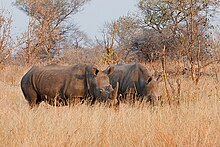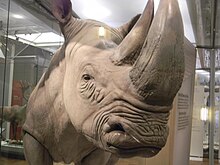Southern white rhinoceros
| Southern white rhinoceros | |
|---|---|

| |
| A southern white rhinoceros in Pilanesberg National Park, South Africa | |
| Scientific classification | |
| Domain: | Eukaryota |
| Kingdom: | Animalia |
| Phylum: | Chordata |
| Class: | Mammalia |
| Order: | Perissodactyla |
| Family: | Rhinocerotidae |
| Genus: | Ceratotherium |
| Species: | |
| Subspecies: | C. s. simum
|
| Trinomial name | |
| Ceratotherium simum simum (Burchell, 1817)
| |

| |
| Southern white rhino distribution range according to the IUCN.
Extant (Resident)
Extant and reintroduced (Resident)
Extant and assisted colonisation (Resident)
Presence uncertain & assisted colonisation
| |
| Synonyms | |
| |
The southern white rhinoceros or southern white rhino (Ceratotherium simum simum) is one of the two subspecies of the white rhinoceros (the other being the much rarer northern white rhinoceros). It is the most common and widespread subspecies of rhinoceros.
Taxonomic and evolutionary history
The southern white rhinoceros is the
Ceratotherium simum kiaboaba (or Rhinoceros kiaboaba), also known as straight-horned rhinoceros, was proposed as a different subspecies (or species) found near
Following the
Physical descriptions

The southern white rhinoceros is one of largest and heaviest land animals in the world. It has an immense body and large head, a short neck and broad chest. Females weigh around 1,600–1,700 kg (3,530–3,750 lb) and males around 2,000–2,300 kg (4,410–5,070 lb), with specimens of up to 3,600 kilograms (7,940 lb) considered reliable, and larger sizes up to 4,500 kg (9,920 lb) claimed but not verified.[3][4][5][6][7][8] The head-and-body length is 3.35–4 m (11.0–13.1 ft) and a shoulder height of 160–186 cm (5.25–6.10 ft).[4][7] It has two horns on its snout. The front horn is larger than the other horn and averages 60 cm (24 in) in length and can reach 166 cm (65 in) in females.[9][7] Females usually have longer but thinner horns than the males, who have larger but shorter ones. The southern white rhinoceros also has a prominent muscular hump that supports its large head. The colour of this animal can range from yellowish brown to slate grey. Most of its body hair is found on the ear fringes and tail bristles, with the rest distributed sparsely over the rest of the body. The southern white rhino has a distinctive flat, broad mouth that is used for grazing. Southern white rhinos are strictly herbivores (graminivores) that feed on short grasses.
Mating and reproduction
Little is known about southern white rhinoceros mating habits, but females reproduce every 2–3 years. They give birth to a single calf, after a gestation period that lasts around 16 months. Males are never directly involved in the raising of calves; in rare instances, certain rogue individuals may even kill calves that they perceive as future competition, both for resources and bloodline dominance.[10] Newborn calves weigh about 45 kg (100 pounds) at birth. Young usually become independent in 2–3 years.
Habitat and distribution

The southern white rhino lives in the grasslands, savannahs, and shrublands of southern Africa, ranging from South Africa to Zambia. About 98.5% of southern white rhino live in just five countries: South Africa, Namibia, Zimbabwe, Kenya and Uganda.
Population and threats

The southern white rhino is listed as
The southern white rhino was nearly extinct near the end of the 19th century having been reduced to a population of approximately 20–50 animals in
White rhino trophy hunting was legalized and regulated in 1968, and after initial miscalculations is now generally seen to have assisted in the species' recovery by providing incentives for landowners to boost rhino populations.[13]
Conservation status
The subspecies is protected under the
Introduction/reintroduction projects


There are small, reintroduced populations within the historical range of the southern white rhinoceros in
In 2010, nine southern white rhinoceroses were imported from
In captivity
Wild-caught southern white rhinoceros will readily breed in captivity when given appropriate living space, veterinary care, food, and water, as well as the presence of multiple female rhinos of breeding age; many white rhinoceroses seen in zoos today are the direct descendants of a cooperative breeding program initiated in the 1970s to increase the population, and maintain genetic diversity, without capturing individuals from the wild.
However, reproductive rates are fairly low among captive-born female southern white rhinoceroses, potentially due to eating a different diet than would be consumed in the wild. Ongoing research, through
References
- ^ . Retrieved 12 November 2021.
- PMID 20383328.
- ISBN 9780521426374.
- ^ ISBN 0198508239.
- ISBN 978-0-9822619-6-5.
- ISBN 978-0-313-35906-4.
- ^ JSTOR 3503966.
- PMID 15101412.
- ^ Heller, E. (1913). "The white rhinoceros". Smithsonian Misc. Coll. 61 (1).
- ^ https://africafreak.com/baby-rhino#:~:text=Adult%20males%20sometimes%20attack%20or,safe%20from%20their%20own%20kin.
- ^ Emslie, R.H.; Amin, R.; Koch, R. "Guidelines for the in situ re-introduction and translocation of African and Asian rhinoceros" (PDF). Retrieved 18 March 2023.
- ^ . Retrieved 18 March 2023.
- ^ Michael 't Sas-Rolfes. "Saving African Rhinos: A Market Success Story" (PDF). Archived from the original (PDF) on 14 January 2016. Retrieved 27 September 2015.
{{cite journal}}: Cite journal requires|journal=(help) - ^ "Appendices". Convention on International Trade in Endangered Species. CITES. Retrieved 18 March 2023.
- ISBN 2-8317-0502-9.
- ^ Lutalo, Eric (14 May 2017). "Ziwa sanctuary where rhinos have a lease of life". www.rhinofund.org. Archived from the original on 2021-05-06. Retrieved 2019-05-15.
- ^ Patrick Scally, "Rhinos reintroduced to Yunnan" GoKunming.com Archived 2017-10-08 at the Wayback Machine 2013-04-02
- ^ (Chinese) 13、中央电视台新闻频道-[新闻直播间]云南普洱:白犀牛今天进行 2014-05-13
- ^ Association of Zoos and Aquariums (2017). "Species Survival Plans".
- ^ San Diego Zoo Global Public Relations (2017). "Rhino Born Thanks to Science".
- ^ Radio Interview (2021). "White Rhino CBO on The Joyride".
- ^ Getaway Magazine (2021). "North West breeder aims to rewild 100 rhinos annually".
- ^ "Our Story". rhinos.mobi. 2022. Retrieved 28 August 2022.
- ^ "Can farming rhinos for their horns save the species?". The Daily Telegraph. November 11, 2017. Retrieved 26 July 2018.
Notes
- ^ Ceratotherium simum POOSAY populations of South Africa and Eswatini are included in Appendix II for the exclusive purpose of allowing international trade in live animals to appropriate and acceptable destinations and hunting trophies. The population of Namibia is included in Appendix II for the exclusive purpose of allowing international trade in live animals for in-situ conservation only and only within the natural and historical range of Ceratotherium simum in Africa.

